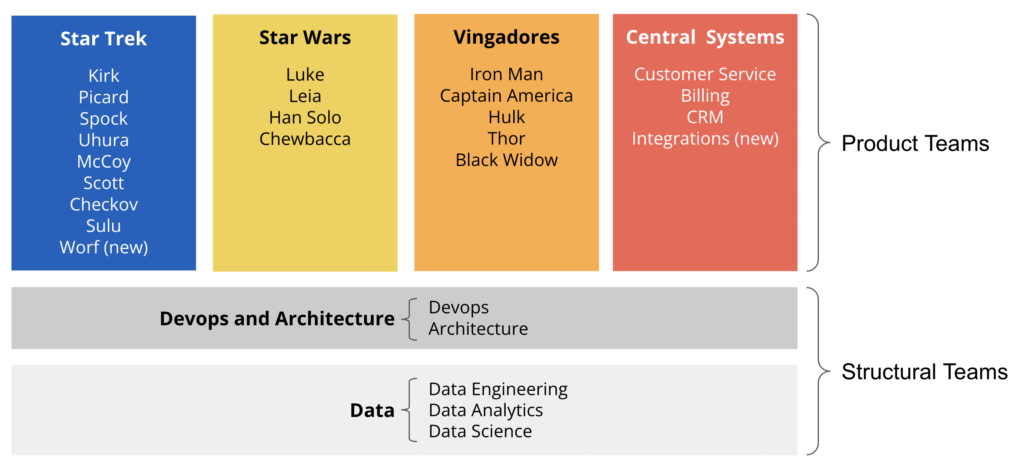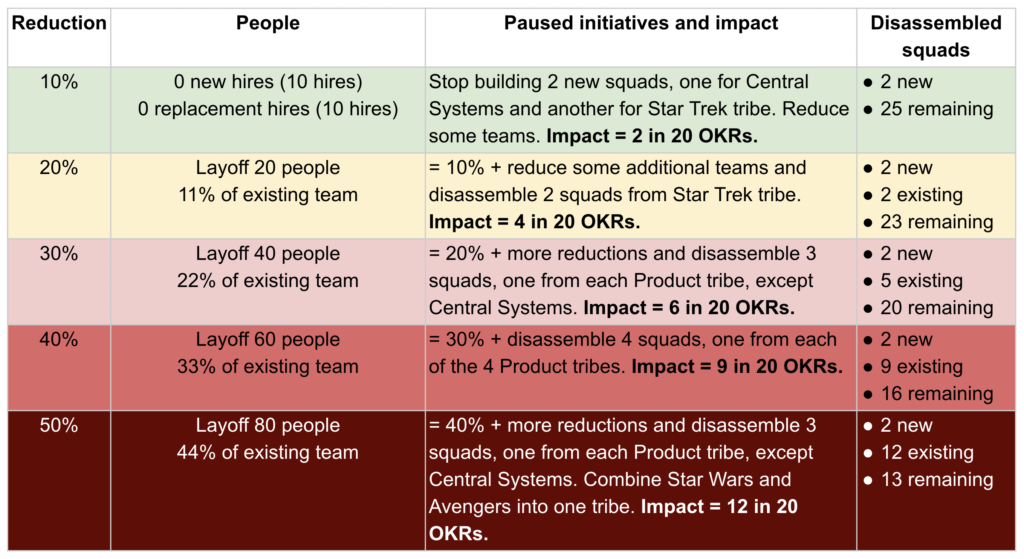Happy 2023!!!
2 de January, 2023Does the shoemaker’s son always go barefoot?
31 de January, 2023During my 30+ years leading teams in technology companies, I have seen and felt the effects of some crises and recessions. According to Wikipedia, since 1990, there have been 4 US recessions, the most recent being COVID-19 in early 2020. According to the Recession Probability Model by The Conference Board, a global non-profit research organization about future scenarios, we are on the verge of another recession:

Downsizing and layoffs are commonly used tools in times of crisis and recession. They seem to be used more in technology companies, as these types of companies tend to move and adapt faster. Tech companies seek capital from investment funds to accelerate their growth, but when a crisis strikes, they need to readjust very quickly. However, downsizing and layoffs are not exclusive to technology companies. Tyson Foods, one of the largest US meat companies, and Goldman Sachs, a global financial market company, also announced layoffs at the turn of the year.
Even in favorable economic scenarios, crises can happen due to internal reasons. It’s possible that some decisions did not prove right, which can cause a company crisis without any influence from the economic scenario. A well-known example is Enron Corporation, one of the world’s leading energy distribution and communications companies, which earned US$ 101B in 2000 and, in 2001, filed for bankruptcy due to accounting and tax fraud and a debt of US$ 13B. More recently, we have the case of Americanas. This large Brazilian retail company started 2023 in crisis for failing to record a BRL 20B debt in its audited balance sheets.
As I explained in the article “Product Management in a Crisis“, companies must analyze two perspectives when they realize that they are entering a crisis:
- preserve cash;
- identify and adapt to changes in customer problems and needs.
To preserve cash, we should look at the most common causes. We should aim to preserve or even advance revenue streams while looking at all costs with a magnifying glass. In this cost analysis, the downsizing and layoff tools that we see being applied in many technology companies and non-technology companies, such as the examples I mentioned above (Tyson Foods and Goldman Sachs), come into play.
How to analyze and plan a layoff in a product development team
Throughout my career, I’ve been through some crises and had to make decisions to reduce the team. More recently, as an advisor, I have also been helping some product heads and CEOs with their layoff decisions and planning.
I will not go into the people management aspect of this process here, as there are many good articles on this topic, giving details of what to do and what not to do. In this regard, my recommendation is to use empathy to define the best way to act. If I were fired, how would I want to be treated? If I wasn’t fired and stayed at the company that went through a layoff, how would I react to the layoffs and how would I like to be treated? Always work very closely with the people management team. It is not uncommon to have people on this team with a background in psychology, which can help a lot in this planning.
In this article I will talk about the part of the layoff process related to planning to reduce the product development team. How to decrease the team? Should I just reduce the amount of people in all squads and keep the same amount of squads? Or should I think about dismantling some squads? Here are my recommendations:
- If you are the main leader of the product development team, or if you share that leadership with a CTO person, I recommend that you do not design the plan alone. Call your direct reports, share with them the need for a team reduction, and start working together on this plan. It is important that your direct reports participate, as they have more knowledge and, consequently, the ability to go into greater detail in the planning. You may wonder if you have leaders with this degree of maturity, which is a relevant concern. It is usually situations like this that help a professional to mature. So if any of them aren’t mature enough, this may be a good maturing opportunity.
- Instead of just making a single reduction plan, design scenarios. If the need is to reduce by 40%, try drawing scenarios with less and more reduction, for example, 10%, 20%, 30%, 40%, and 50%. In these designed scenarios, it is important to make the impacts clear in addition to the reduction achieved. A good way to make impacts clear is with OKRs. In each scenario, which objectives will not be achieved and results will not be reached?
- Start by planning reductions of the vacancies. It is common to have open vacancies of two types, new vacancies for new teams that we plan to set up to run new initiatives or to reinforce existing teams and replacement vacancies to replace people who have left. Plan to reduce new vacancies first. Then the replacement ones.
- If the reduction or elimination of open positions is not enough for the necessary reduction, you should start thinking about reducing the current teams. A very common mistake that I see some people make is to reduce the size of the teams but maintain the number of teams, hoping to be able to continue running all the current initiatives, to reach all defined OKRs, but with fewer people and, consequently, at a slower pace. This is not a good idea. As we say in Portuguese, this is the famous “short blanket problem”. If you cover your head, you uncover your feet. This is the time to prioritize. Which squads can we not dismantle because they are critical to the product’s operation? Which squads were betting on new initiatives, features, and products that we can pause? Is there any initiative, functionality, or product that is not giving the expected results and does not show that it will generate the expected results?
- Design the various reduction scenarios and analyze how many new initiatives are cut in each one that, in times of crisis, can be suspended and how many vital needs for the operation of your product are cut. How do these scenarios impact achieving the product vision and executing the product strategy? Which OKRs will be impacted? Which objectives will not be reached and which key results will not be achieved? This is an important prioritization exercise that, along with the different scenarios, will not only allow you and your direct leaders to see the impact of the reductions on the team, but it is also a great tool for you to present to the CEO and other leaders of the company, showing what different levels of reduction can impact on the company as a whole. In this conversation with the CEO and other leaders of the company, you can decide which is the best – or the least bad – scenario to follow.
Example of analysis and planning of a layoff in a product development team
I will use a hypothetical case to illustrate this example, where I will show the scenery design tool.
The crisis arrived and, after careful analysis of the numbers, you, as the leader of your company’s product development area, reached the conclusion, or received a request from the CEO, that a layoff will be necessary, that is, you will have to reduce the size of the team and will have to make some layoffs. The reduction will need to be 40% of your budget.
You lead a team of 200 people, with a current team of 180 people plus 20 vacancies. Of these 20 vacancies, 10 are new vacancies and 10 are replacement vacancies. The 180 people are divided into 4 product tribes plus 2 structural team tribes as shown below. The 10 new vacancies are to form 2 new squads, the Worf squad in the Star Trek tribe, and the Integrations squad in the Central Systems tribe.

This team of 200 people is focused on achieving 20 objectives and their key results (OKRs). After conversations with your direct reports, and following the steps described above, you can create the following scenarios.

I’ve used this scenario table in a few situations in my career, and I’ve recommended it to product heads, engineering heads, and CEOs who do advisory sessions with me. With these scenarios in hand, you can now talk to the CEO and other company leaders to show the impact of the reduction, as well as alternatives for smaller reductions with also smaller impacts on the productivity of the product development team, so that you can evaluate the options.
Having fewer people will cause the team to drop some balls, meaning you have to make a decision on what to stop doing. Some objectives and expected key results should be deprioritized, as we will have to lay off some people and we will have a smaller team. It’s that simple. Less money implies a smaller team, which implies less things that this team can do and, consequently, less objetives can be achieved and key results can be achieved.
Summing up
- Crises happen with some frequency. In 2020 we experienced the COVID-19 crisis. By early 2023 we may be heading into a recession. And even without an external crisis, companies may have made decisions that were not right.
- When a crisis happens, we have to preserve cash.
- One of the ways to preserve cash is to reduce the size of the product development team, that is, to downsize and layoff.
- When analyzing and planning the layoff, we must design scenarios that allow us to understand the impact of each scenario on achieving the product vision and executing the product strategy. A good way to make impacts clear is with OKRs. In each scenario, make it clear which OKRs will be impacted.
Digital product training, coaching, and advisory
I’ve been helping companies bridge the gap between business and technology through training, coaching, and advisory services on digital product development and management. Check here how I can help you and your company.
Newsletter
I write regularly about product management, product development, digital product leadership, and digital transformation. You can receive a notification whenever I publish a new article, without depending on any social network algorithms to notify you! Just subscribe to my newsletter.
Digital Product Management Books
Do you work with digital products? Do you want to know more about how to manage a digital product to increase its chances of success, solve its user’s problems and achieve the company objectives? Check out my Digital Product Management bundle with my 3 books where I share what I learned during my 30+ years of experience in creating and managing digital products:
- Startup Guide: How startups and established companies can create profitable digital products
- Product Management: How to increase the chances of success of your digital product
- Leading Product Development: The art and science of managing product teams
You can also acquire the books individually, by clicking on their titles above.

